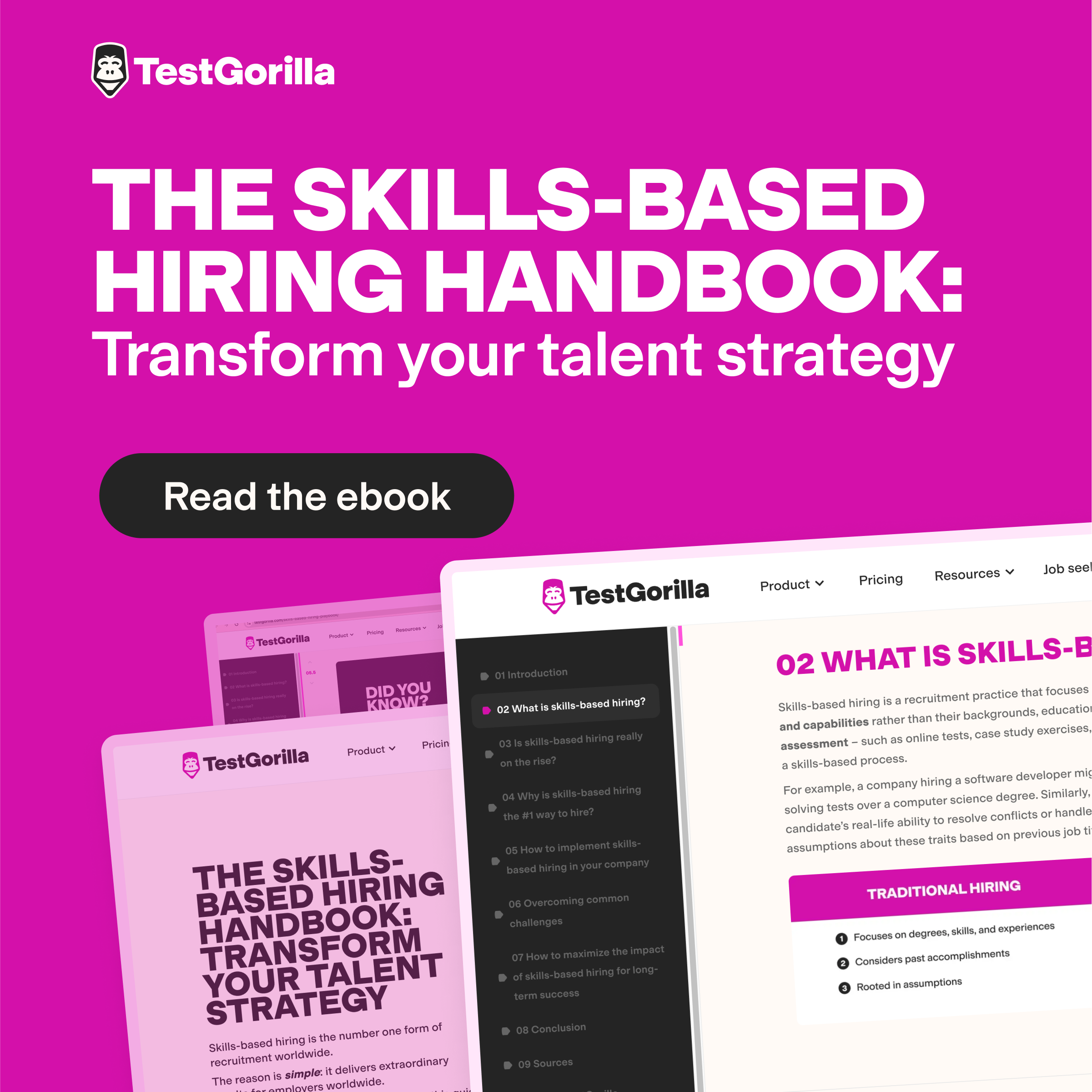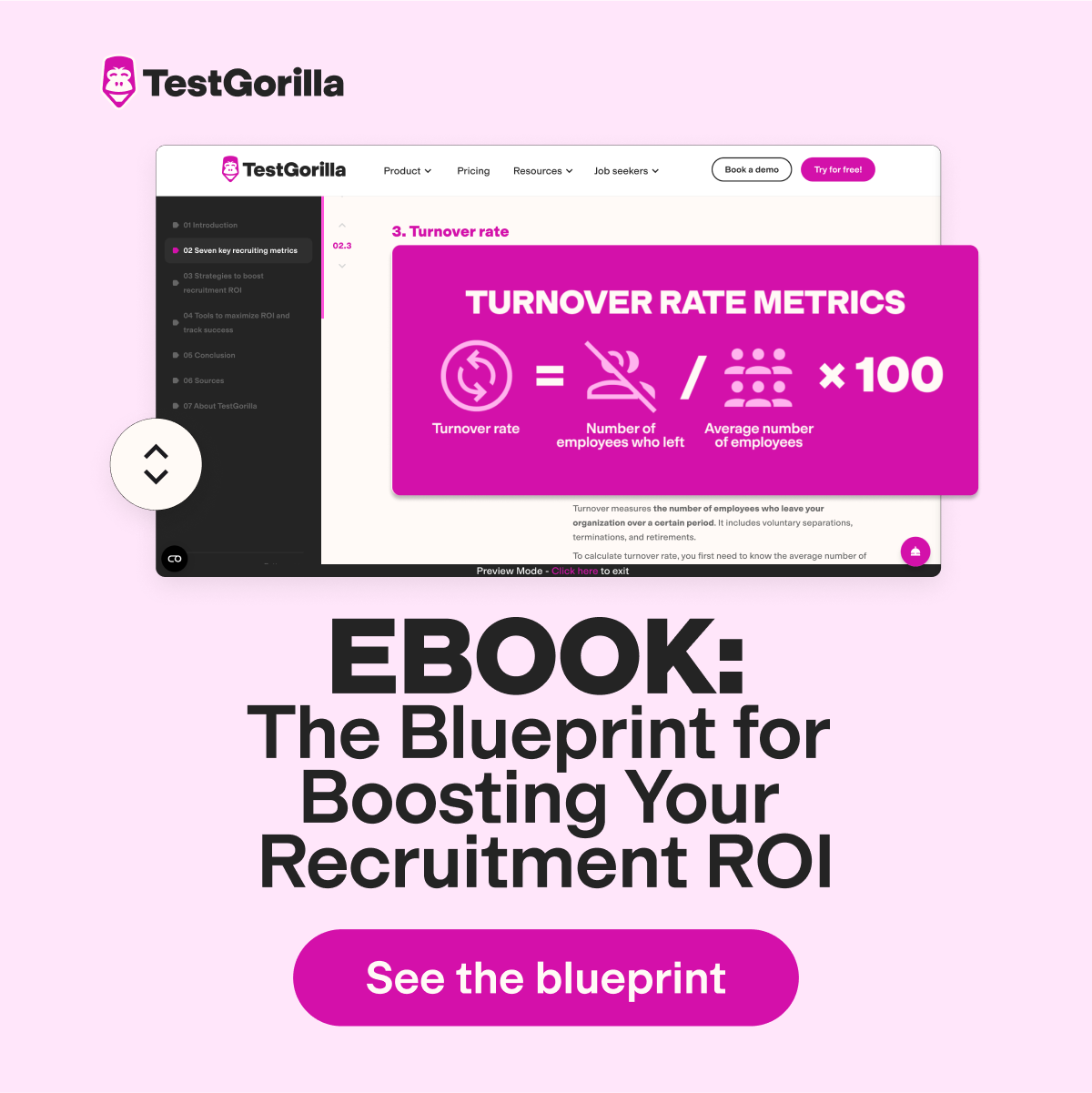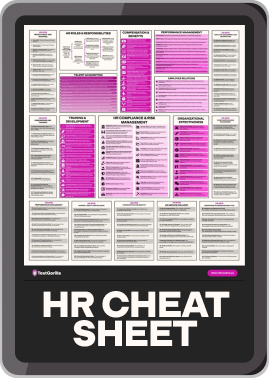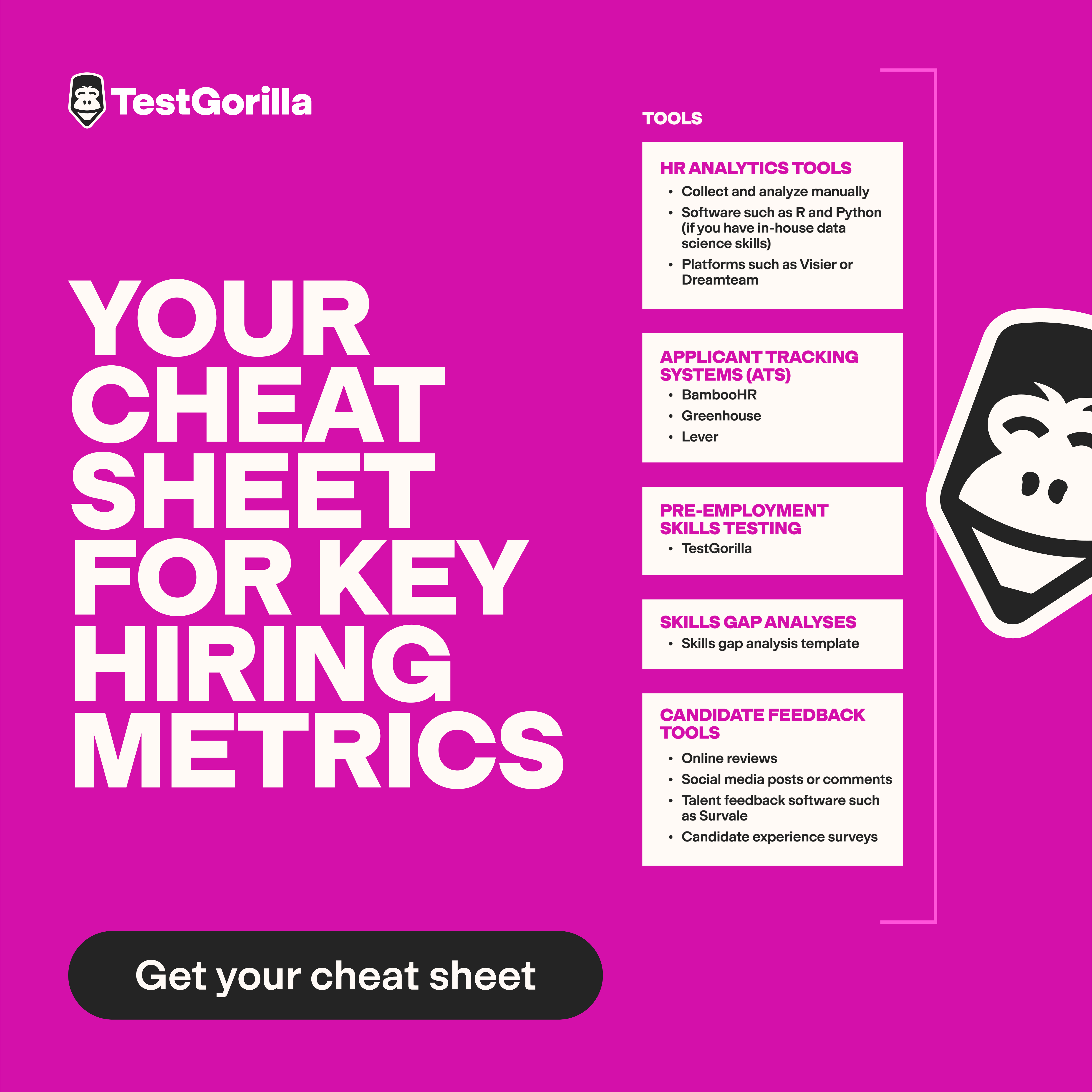Retention bonus: What is it, how does it work, and when should you use this incentive?
Employee retention is a priority for most employers, especially in the context of a global skills shortage and given the cost of new hires.
One popular method for addressing the issue is offering retention bonuses. However, it’s a case of buyer beware when it comes to this approach.
While they can be useful for keeping unique talent or getting a project over the line, they’re not a silver bullet for high employee turnover.
In this article, we look at what retention bonuses are, exactly how they work, and when you should (or shouldn’t) use them.
Table of contents
- What is a retention bonus, and when do companies use it?
- How do employee retention bonuses work? FAQs
- 5 benefits of offering employee retention bonuses
- When retention bonuses aren’t the answer: 3 scenarios when you shouldn’t choose this incentive
- Use a skills-based approach to hire teams you won’t need a retention bonus to keep around
What is a retention bonus, and when do companies use it?
A retention bonus is a strategic tool designed to encourage employees to stay with an organization for a certain amount of time, often during critical periods like major projects or mergers. If the employee leaves earlier, they usually have to repay part or all of the bonus.
These bonuses are a type of employee retention strategy and are also sometimes called employee retention bonuses (ERBs), stay bonuses, retention pay, or retention packages.
Businesses might offer retention bonuses in situations such as:
Key talent retention: To persuade senior employees or those with specialized skills to turn down competitor offers.
Project completion: To ensure key team members stay until the project is successfully delivered.
New hires: To encourage high-value employees to stay beyond onboarding or their probation period.
Talent acquisition: To attract top talent and stand out from other employers.
Organizational change: To maintain stability and facilitate a smooth transition during mergers, acquisitions, or organizational restructuring.
While retention bonuses can be a useful tool for encouraging employees to stay, they’re not a stand-alone solution. Instead, you should use them alongside other employee retention strategies, including:
Building an inclusive workplace culture
Taking a skills-based approach to hiring
Using skills assessments to hire the right people
Working with employees to create professional development plans
Collecting and responding to employee feedback
To learn more about these other approaches, read our comprehensive guide to effective employee retention strategies.
How do employee retention bonuses work? FAQs
Below, we explore some commonly asked questions surrounding employee retention bonuses.
What are retention bonus agreements?
To award a retention bonus, employers must draw up a legal document between themselves and the employee, setting out the terms and conditions of the bonus, including:
How long the employee has to work at the organization to receive it
How much the bonus is
How and when the company pays it, including whether it’s paid in parts or as a lump sum
How the bonus is taxed
Whether the bonus is conditional on any performance benchmarks and the details of them
How is a retention bonus paid?
You can pay a retention bonus:
As a lump sum upfront or at the end of the retention period, for example, you pay the employee $45,000 after they have worked for you for 12 months.
In regular installments. Continuing our $45,000 retention bonus example, you pay the employee $3,750 each month for 12 months.
In part payments. For instance, you pay the employee receiving the $45,000 retention bonus $9,000 (20% of the bonus) initially and then $36,000 (80%) after 12 months.
It’s essential to set out these details clearly in the retention bonus agreement.
How is a retention bonus taxed?
Retention bonuses are subject to the following taxes:
Federal income
State income (depending on the state)
Medicare
Social Security
For federal tax purposes, bonuses are treated as supplemental wages – income received in addition to an employee’s regular wages. The tax rate depends on how you pay the retention bonus.
If you combine it with an employee’s regular wages without distinguishing the amount of regular wages versus the amount of supplemental wages, it will be taxed at the employee’s applicable income tax rate.
If you pay the retention bonus separately from an employee’s wages (or with an employee’s wages, but specify the amount of it), you can choose to either:
Withhold 22%, or
Withhold the applicable federal income tax rate
You can only choose between these options if you already withheld income tax from the employee’s regular wages this year or the previous year. You must use the second option if you haven’t withheld any tax.
Special tax rules apply to employees who receive over $1 million in supplemental wages in a year.
Before offering retention bonuses, it’s a good idea to seek advice from your accountant or tax advisor to understand your tax obligations.
Which employees qualify for a retention bonus?
In theory, any employee is eligible for a retention package. In practice, it’s most commonly used to reward and retain groups of employees who bring significant value to your organization or whose absence would incur a great cost.
The workers who are best suited for retention bonuses usually fulfill one or more of the below criteria:
They are full-time employees who put in at least 30 hours per week
They have worked for the company for a significant amount of time
They are highly skilled in their role, organization, or industry
With this in mind, retention bonuses are most often given to senior employees or high performers when losing them would harm the success of the company or a particular program.
An example is a chief operating officer seeing a business through a difficult transition or a senior developer managing a complex project.
Research by Panopto found that 42% of valuable company knowledge is unique to the individual employee.
The more central to a key project an employee is or the higher up they are in your organization, the more critical the loss is when they walk out the door.
How do you calculate a retention bonus?
Generally, a retention bonus is between 10% and 25% of an employee’s annual salary.
When deciding on the amount, take into account the following:
The financial situation of the company
The period of time you need the employee to stay
The employee's base pay and how long they've worked for you
The employee’s role and seniority
The impact of losing the employee
Current projects (their length and revenue potential)
Salary benchmark data (if an employee is making a below-average salary, the retention bonus helps make up for it)
The likelihood that they leave
That last one is a key point.
Data from McKinsey suggests that large swathes of the workforce are already considering leaving their jobs, and high performers are particularly prominent among them.
The more ready they are to leave, the greater the incentive must be for them to stay.
Do employees leave after collecting their retention bonus?
Some employees may quit after receiving their bonus. Retention pay sends a message: “You can’t leave during this period,” which carries the implicit counter-message that employees can leave once that retention period is over.
Retention bonuses are not a long-term fix to employee turnover because they put an end date on an employee’s loyalty to a company.
Realistically, you should chiefly use retention bonuses for workers you expect to leave soon. They’re an effective tool to manage the transition and make time for succession planning.
You can also use them to show extra appreciation for a team member’s work on a specific project. However, a performance bonus is less risky if this employee is already motivated and engaged.
A strategic retention bonus scheme combined with other employee retention strategies is the best approach to building employee loyalty and reducing turnover.
Understanding the factors behind turnover can inform your retention strategies. Learn more in our article on employee turnover rates.
The best insights on HR and recruitment, delivered to your inbox.
Biweekly updates. No spam. Unsubscribe any time.
5 benefits of offering employee retention bonuses
You’re probably in a tough spot if you’re considering retention bonuses. If that’s you, here’s the short version so you can make a quick decision.
Summary table
The benefits of employee retention bonuses | Examples |
1. It helps retain employees at critical moments for your company | Writing retention bonuses into contracts for project-based workers to ensure they don’t drop out. |
2. It’s cheaper than offering a raise | When an employee’s value temporarily rises, for instance, during a key project. |
3. You maintain a consistent external image | A startup facing turnover when entering a new round of funding. |
4. It avoids spending time and money on hiring | The cost of one new hire is reportedly $4,700. A retention bonus could avert a budget disaster if it halts churn. |
5. It improves employee engagement and performance | Employee engagement rises when you offer retention bonuses. |
1. It helps retain employees at critical moments for your company
The most obvious benefit of retention bonuses is that they help retain employees at important moments for your organization. You could be retaining:
A project leader until the end of the project
A pillar of institutional knowledge during a merger or acquisition
A key member of the executive team during a period of restructuring
Keeping workers with deep knowledge of a product or project on board helps provide continuity to your team and ensures that projects don’t stall. It minimizes disruptions, giving employees the time and opportunity to grow and learn from each other.
Retention bonuses are an especially popular tool for encouraging leadership to stay. For example, they’re commonly used by financial institutions on a grand scale. Recently, Goldman Sachs gave each its CEO and President an $80 million retention bonus (paid as stock).
In justifying these large bonuses, the Goldman Sachs board said they were designed to “sustain the strong momentum they have demonstrated in executing on our firmwide strategic priorities, help ensure stability and continuity in our senior leadership over the next five years, and maintain a strong succession plan for the future of the firm.”
While this approach may encourage a minimum number of workers to stay through a phase or project, it’s not a long-term fix to employee turnover.
2. It’s cheaper than offering a raise
You may wonder whether offering your employees a raise is easier if you want them to stay. However, this isn’t the best strategic option.
Alicia Scott-Wares, total rewards and compensation content director at WorldatWork, an association that conducts annual surveys on bonuses, says, “There is an element of cost-effectiveness in utilizing these [retention] bonuses, as these are each a one-time expense versus an ongoing cost into the future with an increase to base pay.”
Raises can be expensive over the long term, which becomes an issue, particularly if an employee’s most valuable work takes place in the near future.
An example could be a media company switching from a free content model to a subscription model.
In this case, the manager overseeing this transitional period has a high value in the short term because their institutional knowledge and working relationships help them navigate the complexity of the switch.
However, the goal is for that complexity to diminish once the system is up and running. A retention bonus could be a better strategic decision because it targets this project.
3. You maintain a consistent external image
We all know that a spike in turnover is not a good look for your organization.
For candidates, high turnover could indicate that your work environment is stressful or that workers are underappreciated or underpaid.
These impressions have very real consequences. 74% of employees say they have or would reject a job offer if a company’s culture wasn’t a good fit.
For investors and clients, high turnover can be a sign of mismanagement and can make them think twice about working with you.
If high turnover is a long-term issue in your organization, a short-term fix like a retention bonus is not the answer. The same problems can reoccur, and you end up spending a large sum of money plugging holes in a sinking ship.
However, if you run into a short-term challenge that could cause workers to leave – for instance, a stressful merger – a retention bonus scheme is a good stopgap measure.
While retention bonuses can be a useful tool in situations like these, you should never rely solely on them to address retention. Instead, use them alongside other proven long-term strategies like effective hiring practices, fair compensation, and employee recognition.
4. It avoids spending time and money on hiring
Starting a hiring initiative in the middle of a large project is a burden for your teams and budget.
Calculating the cost of turnover isn’t straightforward, but when a new employee costs roughly $4,700, it’s likely to be significant.
One unexpected dropout could put a team or a project at risk. Numerous walkouts across the business could put you in serious financial difficulty.
Financial issues apply even to rehiring human resources who have previously worked with you, often known as “boomerang employees.”
Research into the boomerang employee phenomenon shows that a quarter of returning workers were previous high performers. Their return represents lost profits from their departure and additional resources spent on rehiring them.
Rehiring former employees also incurs extra costs because they earn an average of 25% higher pay than before leaving and gain a boost in responsibility in many cases.
The good news is that rehiring employees is a sign you’re doing something right regarding your culture. The bad news is that the rehiring process is often even more expensive than the hiring process.
Retention bonuses could be a way of avoiding this.
5. It improves employee engagement and performance
High turnover has a proven link to low engagement.
Teams with low engagement have as much as 43% higher turnover than those with high engagement.
High turnover has knock-on effects on business success. Organizations in the top 25% of companies for employee engagement are 23% more profitable than those in the bottom quartile.
Although causation is hard to find here, it’s safe to assume that there’s a mutual relationship.
A lack of engagement causes team members to seek opportunities elsewhere, and constant churn deters employees from engaging in their work.
As mentioned, retention bonuses are not a silver bullet for deep-rooted issues in your team or company culture. You need strong supportive strategies to address team engagement (more about these below).
However, by averting a spike in turnover, you can avoid a drop in engagement and break this cycle.
Avoiding disengagement is particularly effective when you include a performance requirement for retention bonuses because this motivates the employee to remain engaged.
Other workers may even perform better to enter a retention bonus agreement.
Without the right supportive strategies, managing employees’ performance could be more difficult as they “wait out the clock.”
When retention bonuses aren’t the answer: 3 scenarios when you shouldn’t choose this incentive
We’ve discussed the scenarios in which retention bonuses are a good incentive to offer workers, and we’ve also mentioned that they’re not always the right answer.
Here are three scenarios in which you should avoid offering retention bonuses – and alternative strategies you can use instead.
1. To nurture long-term retention
Retention bonuses are for short-term retention and usually focus on overcoming a specific challenge. A retention bonus doesn’t replace fair compensation and a good culture.
Ultimately, if an employee can find a significantly better salary and satisfaction with a competitor, they will likely choose that over a short-term payout.
Most employers deploy retention bonuses through management discretion rather than a blanket policy – for example, only workers above a certain pay grade or tenure are eligible.
A blanket policy could incentivize workers to work until their retention payout and then move on, merely slowing employee churn.
An alternative retention strategy is to use skills-based compensation to motivate employees and skills-based learning to develop their skills.
Skills-based compensation determines employees’ salaries according to the value of their skills to the organization rather than experience or rank.
Combined with skills-based learning, which focuses on the hands-on application of skills, this fosters a learning mindset in workers and gives them clear routes to advancement.
Skills-based compensation and learning have a positive effect on retention.
The McKinsey data cited earlier shows that lack of career development and advancement opportunities and inadequate compensation were the top two reasons for people quitting their jobs in 2022.
It could even attract new workers: 48% of American workers would switch to a new job if offered skills training opportunities.
2. To counteract a toxic culture
You could be considering a retention bonus to halt the churn in a troubled team or because you suspect some of your employees of “quiet quitting” owing to a toxic culture in your organization.
In cases like these, retention bonuses should not be your only strategy.
Instead, consider investing in skills-based hiring to hire workers who share core values and motivation to ensure that a common purpose unites workers with diverse skills and mindsets.
The benefits are widespread. Deloitte found that skills-based organizations were almost twice as likely to retain high performers and more than twice as likely to innovate.
3. To make up for a conflict
On a related note, you should not use a retention bonus to compensate for a team conflict or smooth over resentments that have not yet escalated to an open conflict.
For example, retention bonuses can’t fix a team in which a heated disagreement leads to one or more employees threatening to leave.
Using a retention bonus here could breed more ill will because employees could feel you favor one employee over another.
It also fails to address the core of the issue.
Essentially, you’re trapping workers in a working situation that has broken down.
In cases like these, use nonviolent communication to resolve the core dispute and apply strategies to promote psychological safety at work.
For instance, you could design a specific process to deal with toxic behaviors, including:
Discussing toxic behaviors during 1:1 meetings
Implementing coaching and mentoring
Designing courses on workplace behavior
Encouraging employees to report toxic behavior
Use a skills-based approach to hire teams you won’t need a retention bonus to keep around
Ultimately, retention bonuses are most effective as a last resort.
When you’re in the triage stage of an organizational crisis or fighting to break a churn cycle in a troubled team, a retention bonus can show your existing employees you value them and want them to stick around.
For longer-term issues, you need a broader policy. The foundation of this should be an effective skills-based approach to recruitment, ensuring you hire people who are going to stick around. Other strategies like fair compensation, a strong company culture, and employee recognition encourage employees to stay and reduce turnover.
TestGorilla’s skills assessments are a great way to assess and compare candidates' hard and soft skills while reducing hiring bias.
Sign up for a free plan today to see how TestGorilla can help you hire the right people who are in it for the long haul.
You've scrolled this far
Why not try TestGorilla for free, and see what happens when you put skills first.


















